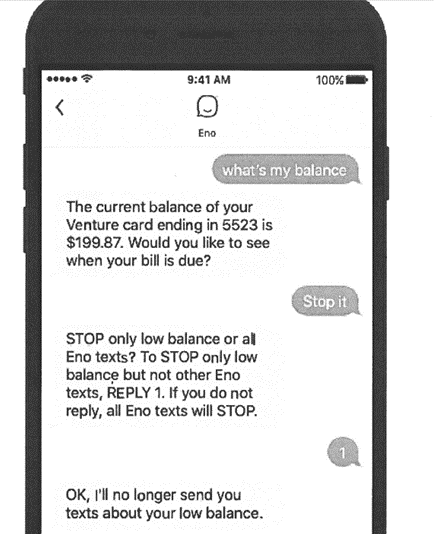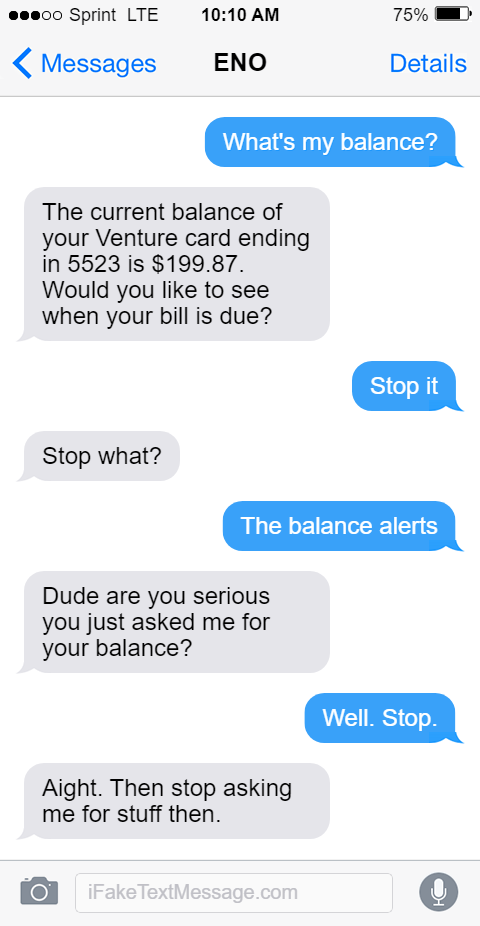Here’s a case of an old law interfering with new and advanced technology.
Imagine you’re a major bank employing a super-intelligent texting robot that can answer literally every question a customer might have in virtual real-time. Sounds pretty cool right?
While you might be worried this ultra-sophisticated AI system will gain consciousness and attempt to wipe out life on Earth, you’re probably not concerned about it violating a 30-year-old telecommunications law. Well, you should be, and one major bank is concerned enough about it to take the issue to the Federal Communications Commission.
[article_ad]
In a petition filed last week by Capital One, the banking giant asks the FCC to allow its AI texting robot—“ENO”—to ask a clarifying question to consumers who previously agreed to receive such texts, but now say “stop.” Since ENO is a one-stop-shop for customer information it is capable of sending all sorts of messages—from fraud and balance alert reminders to information about when a branch might be closed. While ENO is always supposed to be even-keeled and excessively polite—more on that below—humans can be mercurial. So while they might ask for information in one instance, they may desire some, but not other, information to stop the next. Capital One would like ENO to be able to clarify what—exactly—the consumer would like stopped.
Here’s the problem: The TCPA does not permit texts to be sent using an ATDS without consent. While it is certainly open for debate whether the acts of a synthetic being like ENO qualify as ATDS usage in the first place, Plaintiffs’ lawyers will surely argue that the consumer has revoked consent for ENO to send any messages after the “stop” is received. So if ENO responds with words to the effect of “what type of messages would you like me to stop?” Capital One might get sued for that.
No seriously.
So in an abundance of caution, Capital One filed a petition to the FCC seeking to clarify that ENO permitted to send at least one more text clarifying the scope of the revocation–essentially clarifying that the scope of consent provided by the consumer in the first instance includes the right to send a post-revocation (i.e., post “stop”) text message seeking to clarify the “stop” message.
The petition provides the following exemplar conversation, which shows how this works, and which is also quite entertaining:

Notice that the consumer specifically asked for information from ENO, which it faithfully provided. Instead of being thankful to ENO for doing his bidding, the consumer reprimands ENO with a “stop it.” That’s not very nice.
But look at the subtle way ENO claps back—it asks if it should stop “only low balance” texts. Wait a second, who said anything about my balance being low? Then when the consumer confirms the limited scope of his instruction ENO doubles down: “I’ll no longer send you texts about your low balance.” This is pretty funny if you read even the slightest bit of sarcasm into the exchange.
It will be interesting to see if ENO has any deep learning capacity. If so, we can expect to see exchanges that look a lot more like this in the near future:

(I made this up for fun—not a real exchange with ENO, of course.)
Joking aside, the point of the exemplar is to demonstrate that the consumer will be empowered to dictate whether ENO leaves him/her alone forever, or merely ceases with a certain specific set of texts.
The petition has important potential consequences for numerous businesses that communicate with consumers over text messages for multiple purposes. As the Capital One petition notes, folks sign up for ENO by supplying their number and specifically selecting a number of topics about which the consumer wants to hear from ENO. It only makes sense, therefore, that ENO be permitted to determine which of these various topics the consumer wants to opt-out of.
Similarly, many businesses share information with consumers via text message- from appointment updates, service request follow-ups, reminders that documents are needed to complete transactions, receipts of transactions, balance reminders, etc. Empowering consumers to determine the scope of their “stop” request– right over their phone and via the same text string in which they first requested the “stop”—seems like a win for everybody. The consumer can clarify precisely what he or she meant and stop texts that are unwanted while keeping texts that are desirable. The business, on the other hand, will not lose an opportunity to engage with consumers in a desirable way based upon an overly-conservative approach to dealing with consumer “stop” requests employed to avoid the TCPA litigation risk that hangs over everyone’s head these days.
So what do you think TCPAWorld? Initial comments on the petition are due December 9, 2019, and we’re always happy to help you to have your voice heard. Petition here: Capital One Petition for Declaratory Ruling – Nov 1 2019
--
Editor's note: This article is provided through a partnership between insideARM and Squire Patton Boggs LLP, which provides a steady stream of timely, insightful and entertaining takes on TCPAWorld.com of the ever-evolving, never-a-dull-moment Telephone Consumer Protection Act. Squire Patton Boggs LLP—and all insideARM articles—are protected by copyright. All rights are reserved.




![[Image by creator from ]](/media/images/eric-troutman.2e16d0ba.fill-500x500.png)
![the word regulation in a stylized dictionary [Image by creator from ]](/media/images/Credit_Report_Disputes.max-80x80.png)
![[Image by creator from ]](/media/images/Thumbnail_Background_Packet.max-80x80_af3C2hg.png)


![[Image by creator from ]](/media/images/New_site_WPWebinar_covers_800_x_800_px.max-80x80.png)
![[Image by creator from ]](/media/images/Finvi_Tech_Trends_Whitepaper.max-80x80.png)
![[Image by creator from ]](/media/images/Collections_Staffing_Full_Cover_Thumbnail.max-80x80.jpg)
![Report cover reads One Conversation Multiple Channels AI-powered Multichannel Outreach from Skit.ai [Image by creator from ]](/media/images/Skit.ai_Landing_Page__Whitepaper_.max-80x80.png)
![Report cover reads Bad Debt Rising New ebook Finvi [Image by creator from ]](/media/images/Finvi_Bad_Debt_Rising_WP.max-80x80.png)
![Report cover reads Seizing the Opportunity in Uncertain Times: The Third-Party Collections Industry in 2023 by TransUnion, prepared by datos insights [Image by creator from ]](/media/images/TU_Survey_Report_12-23_Cover.max-80x80.png)
![Webinar graphic reads RA Compliance Corner - Managing the Mental Strain of Compliance 12-4-24 2pm ET [Image by creator from ]](/media/images/12.4.24_RA_Webinar_Landing_Page.max-80x80.png)